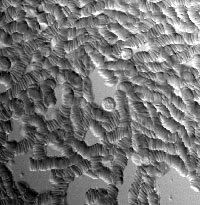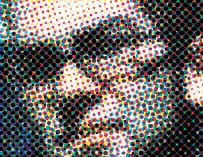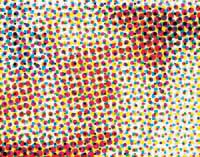| Halftone Model for
Cellular Automata and Emergent Behavior erland sanborn |
|
Keywords: The halftone concept(in a tiny nutshell): Halftoning
is a method for reproducing shades by using a single color ink. Dots
are layed out in a grid with varying radii. At a distance, the eye interperets
a color that is mixed between the ink color and the background color.
A higher density of dots results in a darker shade of the ink color. History: So, what do halftone screens have to do with cellular automata or biology?
Absolutely nothing. But bear with me... |
|
|
biological concept: The submechanisms of cells, subject to brownian motion and environmental stimuli, operate on very simple rules. It is through these mechanisms, organelles, that an organic cell displays its properties as, say muscle, brain tissue, etc. Here we can see a heirarchy of emergent behavior dictated by the fundamental properties of ever smaller parts. As an example of complex emergent behavior with simple origins (in no way an accurate, scientific example): if an emotion is the result of electrochemical interaction between neurons in the brain, anger, for example, is really the product of the system within those neurons. Further, these rules also result from the mechanisms within those mechanisms , again based upon different rules. The heirarchy continues through the molecular level, where "behavior" emerges from basic rules of chemical interaction, which in turn are determined by atomic behavior, subatomic particle behavior, down to... well, no one knows how small.
|
 |
|
Simulation: For this simulation, the biological cell is replaced with the halftone dot. Each dot is governed by the properties of its organs; namely, smaller, single-pixel 'vehicles.' The organs are affected by brownian motion and mutual attraction, and their presence within a cell determines its velocity vector and size (constrained to fit the angle of rotation, maximum radius, and resolution). In addition, each organ will either multiply or die depending on surrounding conditions. Organs will be floating around the 'environment' freely passing in and out of the cells. Once a cell has grown to the maximum size, it will spawn a new cell if certain conditions apply. At it's minimum size, it will simply die. Although this scheme is not based on any true biological system, it demonstrates an analogous hierarchy of emergence. With these rules in place, it is my hope that the halftone dots will begin to exhibit a certain behavior. The resulting interaction of cell colors and size then allow for another set of forms and behaviors at a larger scale. When seen from afar, these color patterns should flatten out as smoother tones, gradations, and edges, giving way to more structured images with notions of mass, depth, and volume. Just as the final image is the result of its cells, which are the result of 'organelle' interaction, the human body itself is the emergent result of an analogous 'atomic' system. |
mockups of possible output |



